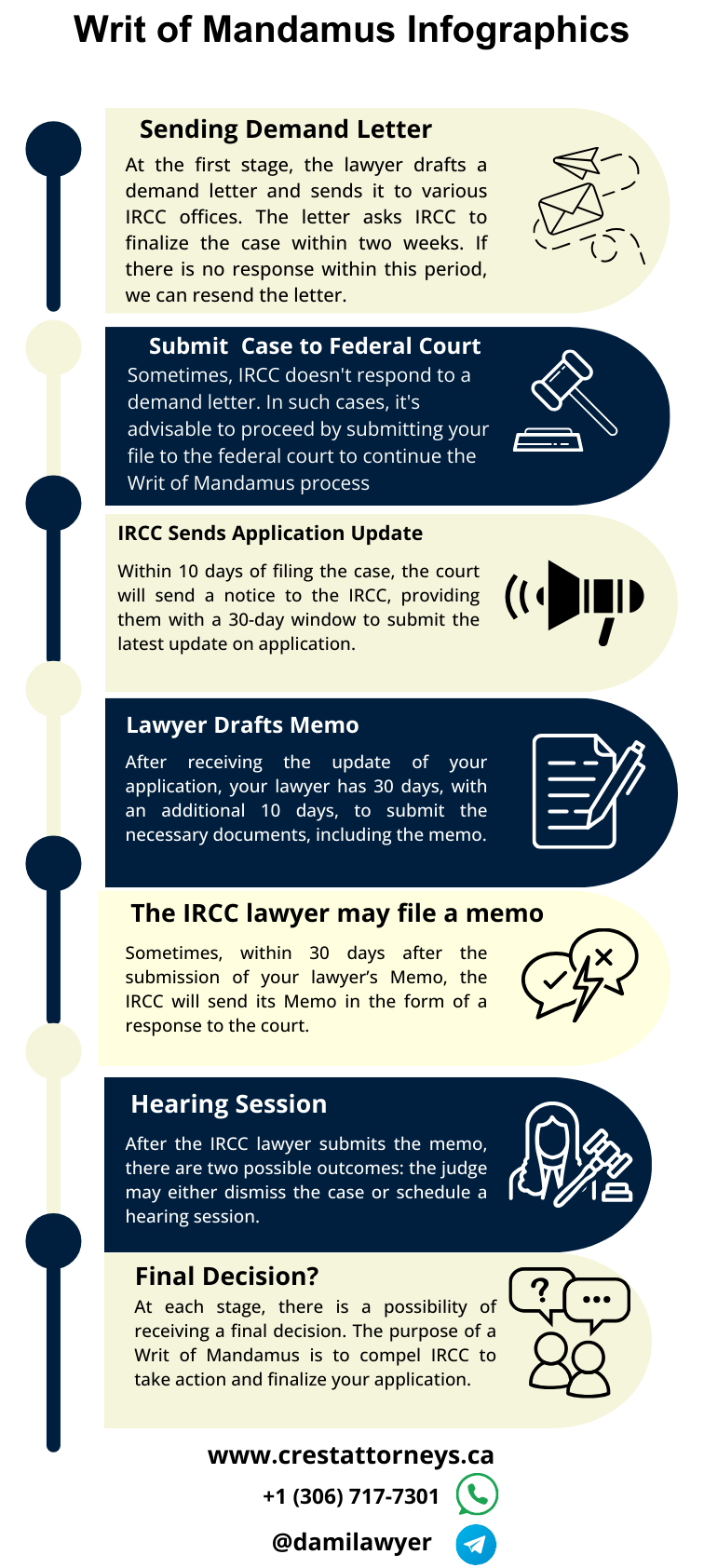The Ultimate Guide to Writ of Mandamus in Canada: What You Need to Know
Are you facing unreasonable delays in your immigration application? Do not panic; many others like you have this problem. At Crest Attorneys, we help clients get final results by filing a Writ of Mandamus. Stop scrolling through your immigration application profile and talk to a lawyer to resolve these issues.

Oluwadamilola Asuni
In this article, all your questions regarding the appeal for rejecting the application have been answered. At the end of the article, by filling out the assesment form, the support team of Crest Attorneys will contact you.
What is a Writ of Mandamus?
A Writ of Mandamus is a court order directing a government official or public body to perform a duty, often used when rights are violated or responsibilities are unmet. It is particularly useful when you are waiting beyond the IRCC processing time for the final decision on your application.
Who is Eligible to File the Writ of Mandamus?
No matter what type of application, if you are waiting longer than the promised processing time given by IRCC, you can start filing a Writ of Mandamus.
In this link, you can check latest IRCC process time .
How Crest Attorneys Tackles IRCC Processing Delays
Crest Attorneys has experience with helping clients overcome delays by helping them apply for a writ of mandamus. The purpose of a writ of mandamus is to help the client get a decision on their immigration application by compelling the Immigration, Refugee and Citizenship Canada (IRCC) to process and determine the already delayed application. Notwithstanding the cause of the delay, Crest Attorneys can help.
Case Studies of Successful Writ of Mandamus Application by Crest Attorneys
Our client had been waiting over two years for their permanent residency application to be finalized, with no response from IRCC. Crest Attorneys filed a Writ of Mandamus on their behalf, and within two months, the client received their final results. This case highlights the effectiveness of strategic legal action in overcoming prolonged administrative delays.

Get Free Consultation
By filling out the assessment form, our support team will contact you as soon as possible
Writ of Mandamus processing time

Writ of Mandamus Process
A writ of mandamus is a legal remedy or a Court order that compels a decision maker or a public officer to perform their duty within a set time frame. In the immigration context, a writ of mandamus can be utilized at the Federal Court to compel administrative decision-makers like the IRCC visa officers or the CBSA officers etc to process and determine a delayed immigration application by a set date. To activate this remedy, a delay must have occurred, and the applicant must not be the cause of the delay.
It is important to note that throughout all stages of mandamus, IRCC may choose to finalize your application. From day 1 when your lawyer sends the demand letter until the hearing session, there's a possibility of getting final results on your application.
Mandamus Process Diagram
1.Sending a demand letter
Sending the demand letter initiates the mandamus process. This action is referred to as stage 1 of mandamus, where the letter requests IRCC to finalize the application .
2. Your case will be filed in federal court by lawyer
If IRCC doesn’t respond to your lawyer’s demand letter, you need to proceed to stage 2. In this stage, your lawyer will file your application in the Federal Court of Canada .
3. IRCC will send the latest update on the application
The parties involved in this lawsuit are you, the applicant, on one side, and on the other side, the IRCC ( Immigration, Refugees and Citizenship Canada), designated as the respondent in court. It’s important to note that the IRCC is also represented by a lawyer.
Within 10 days of filing the case, the court will send a notice to the IRCC, providing them with a 30-day window to submit the latest update on application.
4. Your lawyer filed the Memo.
After receiving the update of your application, your lawyer has 30 days, with an additional 10 days, to submit the necessary documents, including the memo.
In a comprehensive memo, relying on precedent cases that have successfully navigated the court, your lawyer systematically challenges each of the officers(IRCC) for delaying finalizing the application. Ultimately, your lawyer requests the judge to allow the case to proceed to court and ask the officer for final decision
5. The IRCC lawyer may file a memo in response to your lawyer's memo
Sometimes, within 30 days after the submission of your lawyer’s Memo, the IRCC will send its Memo in the form of a response to the court.
In this Memo, the IRCC lawyer will defend IRCC and provide supporting reasons for the delay in finalizing the application
6. Hearing session
In the hearing session, the judge will make a decision on the case, and there are two possible outcomes.

How to Strengthen Your Canadian TRV Application Amid Rising Canada Visa Rejections
Canada visa rejections have surged in 2024, sparking concerns among international students, temporary workers, and visitors. The Canada visa rejection rate increase highlights the importance of proving one’s intention to return home after a temporary stay. Below,...

10 Reasons for the rejection of Canadian Citizenship Applications
Canada is a primary destination for immigrants, offering a high quality of life and global opportunities. However, the journey to becoming a citizen isn’t without challenges. Many applicants face Canada citizenship rejection due to overlooked requirements or errors....

10 Essential Tips to Maintain Permanent Resident Status in Canada
If you're a permanent resident in Canada, maintaining your status requires ongoing effort and attention. Here are 10 essential tips to help you Maintain Permanent Residency Canada and navigate the complexities of Canadian immigration.If you're a permanent resident in...
7. Judge requests IRCC to finalize the application
If the judge allows the case to enter the court, sets a time for the hearing: usually between 30 and 90 days after granting the leave.
8 . The judge dismisses the case
Your content goes here. Edit or remove this text inline or in the module Content settings. You can also style every aspect of this content in the module Design settings and even apply custom CSS to this text in the module Advanced settings.
7. Judge requests IRCC to finalize the application
If the judge allows the case to enter the court, sets a time for the hearing: usually between 30 and 90 days after granting the leave.
8 . The judge dismisses the case
Your content goes here. Edit or remove this text inline or in the module Content settings. You can also style every aspect of this content in the module Design settings and even apply custom CSS to this text in the module Advanced settings.
9. Application will be finalized.
“Throughout all stages of mandamus, IRCC may choose to finalize your application. From day 1 when your lawyer sends the demand letter until the hearing session, there’s a possibility of obtaining final results on your application.
Demand Letter
We have got the numbers: Crest Attorneys assisted hundreds in breaking through immigration delays. How? A powerful demand letter to the IRCC did the trick!
What Is the Next Step for an Unanswered Demand Letter ?
Sometimes, IRCC does not respond to the demand letter. In such a situation, you have two options:
The first option is to send a reminder to IRCC. Mr. Dami will handle this without any additional charge.
We recommend that if you do not receive a response in Stage 1, continue the process to Stage 2 of mandamus because the likelihood of obtaining an answer is higher at this stage.
The second option is to pursue the process in stage 2 of mandamus, which involves filing your application in the Federal Court of Canada. Stage two constitutes a legal trial, and the court will continue proceedings in this matter.
Stage Two of Mandamus
The second stage of writ of mandamus is done at the Federal Court and it only becomes necessary if the delays persist after doing the first stage of mandamus. The second stage of writ of mandamus starts with filling an Application for Leave and Judicial Review (Mandamus) at the Federal Court then the court registry will request the reasons for the delay from the decision-maker and a copy will be provided to the parties.
At Crest Attorneys, our clients usually get a decision on their immigration application before we receive the reasons for the delay from the court registry.
What Is a Hearing Session?
If we receive the reasons for the delay before the immigration application is decided, then an application record (consisting of a memorandum of argument and affidavit etc ) will be submitted to the court on behalf of the client. At this point, most clients doing the writ of mandamus get a decision on their immigration application. Only in a few instances will the decision maker present their own argument which will necessitate an oral hearing and a decision of the court. If the writ of mandamus is successful, the court will compel the decision-maker to render a decision on the application by a set date.
Crest Attorney Mandamus Sucess Story in Hearing Session
The Federal Court ordered that the Minister of Citizenship and Immigration must make a decision on the Applicant’s Temporary Resident Visa (TRV) application within 30 days. The Court granted the application for judicial review, finding that the significant delay in processing the TRV, despite repeated inquiries and compelling personal circumstances, was unreasonable. The Court concluded that the Applicant had met all the legal conditions for a writ of mandamus and emphasized that the Respondent’s justifications for the delay, including background checks, were inadequate. No costs were awarded in this matter.
A Look Back: The History of Mandamus in Canada
The writ of mandamus has its origins in English common law and was introduced into the Canadian legal system through colonial courts. Initially, it was used to challenge actions by federal, provincial, and municipal authorities. Over time, its scope and application have evolved, with courts developing criteria for granting the writ.
Key Developments:
1. Origins in English Common Law: Introduced into Canadian legal system via colonial courts.
2. Early Use:Primarily challenged actions of federal, provincial, and municipal authorities.
3. Evolving Scope:Courts developed a nuanced understanding of when the writ should be granted.
4. Dunsmuir v. New Brunswick (2008): Supreme Court established a new framework for judicial review of administrative decisions, significantly impacting the application of the writ of mandamus.
5. Criteria and Guidance: Dunsmuir’s decision clarified the circumstances and factors for granting the writ.
By understanding these key developments, one can appreciate the historical evolution and current application of the writ of mandamus in Canada.
Factors Affecting the Success Rate of Writ of Mandamus Applications
Several key factors influence the success rate of writ of mandamus applications in Canada:
- Nature of the Legal Duty: Clear, unambiguous, and non-discretionary duties increase the likelihood of the writ being granted.
- Availability of Alternative Remedies: Courts may be less inclined to grant the writ if other legal remedies, such as appeals or judicial reviews, are available.
- Strength of the Applicant’s Case: Compelling evidence and strong legal arguments are crucial.
- Jurisdiction and Court: Success rates vary by jurisdiction and specific court.
- Public Interest: Cases involving significant public interest are more likely to succeed.
- Conduct of Government Officials: Bad faith or improper actions by officials can positively influence the court’s decision.
Understanding these factors helps applicants assess their likelihood of success and tailor their legal strategies accordingly.
The Success Rate of Writ of Mandamus Applications in Canada
The success rate of writ of mandamus applications in Canada can vary depending on a number of factors, including the specific circumstances of the case, the jurisdiction, and the legal arguments presented by the applicant.
While the overall success rate of the writ of mandamus applications in Canada can be challenging, our firm’s expertise and dedicated approach significantly enhance the chances of a favorable outcome
However, it is important to note that this figure is a general estimate and may not accurately reflect the success rate in all jurisdictions or for all cases. The success rate can also vary depending on the specific legal issues involved and the strength of the applicant’s case.
Breaking Down Writ of Mandamus Costs in Canada
The cost of a writ of mandamus typically includes two main components: lawyer fees and a court filing fee, which is $50 CAD. At Crest Attorneys, we understand that many immigrants come from developing countries, and affordability is essential. That’s why we provide competitive and transparent legal fees tailored to your needs.
To learn more about our legal fees for a writ of mandamus, message us on WhatsApp, and our friendly support team will gladly assist you.
Learn more about our legal fees for a writ of mandamus
Ready to File Your Writ of Mandamus? Here's How in Two Steps
Document prepration
The writ of mandamus does not require access to your account on the immigration office website. We only need a scanned passport and a submission letter.
Scan of Passport
Submition Letter
Any additional documents
Sending Documents ; Signing the Agreement ; Payment Process
As the legal representative of Crest Company, Mr. Oluwadamilola Asuni (Dami) is responsible for drafting defense pleadings and request letters. With hundreds of successful Mandamus cases under his belt, Dami is by your side to defend your rights.
After signing the contract, Mr. Oluwadamilola Asuni (Dami) will send the request letter to the immigration office in less than a week.
Sending Documents to Lawyer (via Email)
Signing the Agreement
Completing the Payment Process
Free Consultation
By filling out the assessment form, our support team will contact you as soon as possible
Answers to your legal queries at Crest Attorneys.
Can the second stage of mandamus be completed without first completing the first stage?
No, the second stage necessitates the completion of the first stage of mandamus.
What documentation is required to file a mandamus?
To file a mandamus, you will need a scanned passport and a submission letter
Is it possible for an officer to reject a case for filing a mandamus?
By filing a mandamus, you are only seeking the final result, and officers will never reject your case for filing a mandamus.
Is it necessary to inform your immigration consultant to file a mandamus?
No. There’s no need to inform your immigration consultant, as this action is separate from your profile, and filing a mandamus doesn’t require access to your immigration application.
What is the expected timeframe for receiving a final response after filing a mandamus?
Each case varies, and thus an exact timeframe cannot be provided. However, responses generally occur within one to four months of filing a mandamus.
If you are experiencing delays in the processing of your immigration application, contact Crest Attorneys to help you assess your options and evaluate your chances. Don’t let long delays hinder your immigration plans.
